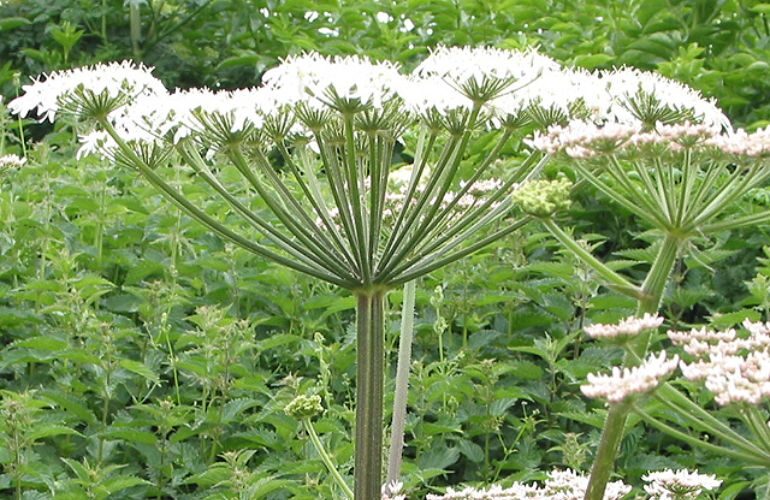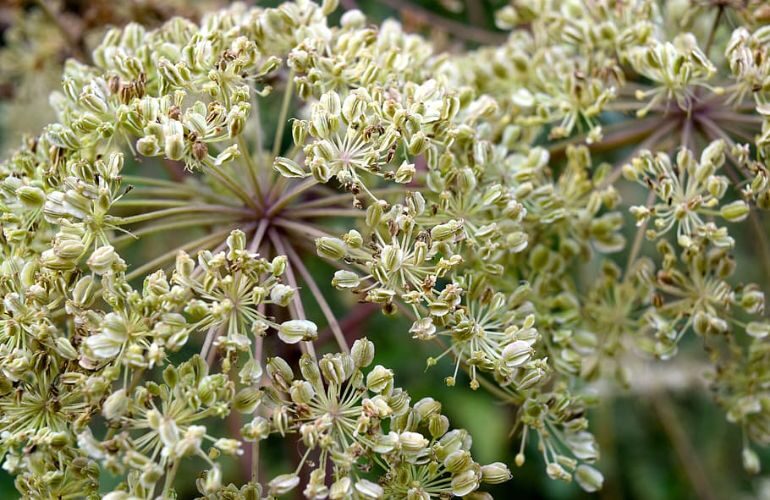Identification
Angelica is a herbaceous plant belonging to the Apiaceae family, which is native to Europe and Asia. The plant is known for its aromatic qualities and is used for culinary and medicinal purposes.
Here are some identifying features of an Angelica plant:
- Appearance: Angelica plants typically grow to a height of 1-2 meters and have thick, hollow stems that are usually purple or green in color. The leaves are large, compound, and toothed, and can grow up to 2 feet long.
- Flowers: Angelica plants produce large umbels of greenish-white flowers that bloom in the summer. The flowers are followed by seeds that are small, black, and ridged.
- Smell: Angelica plants have a distinctive sweet, musky aroma that is often described as similar to licorice.
- Habitat: Angelica plants prefer moist, shaded areas and are often found growing near rivers or in damp woodlands
Various parts of the Angelica plant have been traditionally used for medicinal purposes, including the root, stem, leaves, and seeds. Here are some of the medicinal uses of different parts of the Angelica plant:
- Root: The root of the Angelica plant is commonly used for its medicinal properties. It has been used to treat digestive disorders, such as bloating, gas, and stomach pain. It is also used as a diuretic and to stimulate menstruation.
- Stem: The stem of the Angelica plant is used in traditional Chinese medicine to treat respiratory infections, such as coughs and colds. It is also used to treat rheumatism and arthritis.
- Leaves: The leaves of the Angelica plant are used topically to treat skin conditions, such as psoriasis and eczema. They are also used as a poultice to relieve joint pain and inflammation.
- Seeds: The seeds of the Angelica plant are used to relieve flatulence and indigestion. They are also used to stimulate appetite and aid in digestion.
Common Name
Angelica
Scientific Name
Angelica archangelica
Name in popular languages
- Spanish: Angélica, Hierba del Espíritu Santo
- French: Angélique, Herbe aux anges
- German: Engelwurz, Brustwurz
- Italian: Angelica, Erba degli angeli
- Portuguese: Angélica, Raiz-do-Espírito-Santo
- Dutch: Engelwortel, Aartsengelkruid
- Swedish: Kungsängslilja, Ängelört
- Norwegian: Englekjeks, Kvann
- Danish: Kvan, Helligåndskvan
- Finnish: Enkelinkukka, Viikunalehti
- Hindi: Choraka Bheda, Chorakaa
- Bengali: Choraka
- Kannada: Dhanvayasa
- Malayalam: Entela
- Tamil: Tittiramutti
- Telugu: Gaddamustadi
- Marathi: Ambavani, Ganda
Origin and History
Angelica is believed to be native to northern Europe and Asia, where it has been used for centuries for culinary and medicinal purposes. The plant’s botanical name, Angelica archangelica, is said to refer to the belief that the plant’s roots were revealed to humans by an angel in a dream, and that it could be used to ward off evil spirits.
In traditional European herbal medicine, Angelica has been used to treat a variety of ailments, including digestive disorders, respiratory infections, menstrual disorders, and joint pain. The plant’s aromatic qualities have also made it a popular ingredient in liqueurs and bitters, such as Chartreuse and Vermouth.
In traditional Chinese medicine, Angelica is known as dang gui and is used to tonify blood and regulate menstruation. It is also used to treat respiratory infections and as a general tonic.
Modern research has shown that Angelica contains compounds with anti-inflammatory and antioxidant properties, and it may have potential therapeutic uses for conditions such as rheumatoid arthritis, high blood pressure, and certain types of cancer. However, more research is needed to confirm these effects and determine the appropriate dosages and formulations for therapeutic use.
Overall, Angelica has a long history of use for health and medicinal purposes, and its potential benefits continue to be studied today. However, as with any herbal remedy, it is important to consult with a healthcare provider before using Angelica for medicinal purposes, especially if you are taking other medications or have any underlying health conditions.
Nutritional constituents
Angelica contains a variety of nutritional constituents, including vitamins, minerals, and antioxidants. Here are some of the nutritional constituents found in Angelica and their potential health benefits:
- Vitamins: Angelica is a good source of vitamin C, which is an antioxidant that supports immune function and helps protect against cellular damage. It also contains vitamin B6, which is important for nerve function and helps the body make hemoglobin, a protein in red blood cells that carries oxygen.
- Minerals: Angelica is a good source of potassium, which helps regulate blood pressure and supports muscle and nerve function. It also contains calcium, which is important for bone health, and iron, which is important for the production of red blood cells.
- Antioxidants: Angelica contains several antioxidant compounds, including ferulic acid, umbelliferone, and coumarins, which may help protect against cellular damage and reduce inflammation.
Medicinal or Health Benefits
Angelica has been used traditionally for various health benefits, and some of these uses have been studied in modern research. Here are some potential medicinal or health benefits of Angelica:
- Digestive health: Angelica has been traditionally used to support digestive health and may have anti-inflammatory and gastroprotective effects. Studies suggest that Angelica may help reduce inflammation and oxidative stress in the digestive system, as well as protect against ulcers and other digestive disorders.
- Women’s health: In traditional Chinese medicine, Angelica is commonly used for women’s health issues such as menstrual cramps and irregular periods. Research suggests that Angelica may help regulate menstrual cycles and reduce symptoms of premenstrual syndrome (PMS). Angelica may also have potential benefits for menopausal women, including reducing hot flashes and improving bone density.
- Anti-inflammatory and antioxidant effects: Angelica contains several compounds with anti-inflammatory and antioxidant properties, including ferulic acid and coumarins. These compounds may help reduce inflammation and oxidative stress in the body, which are linked to various chronic diseases such as heart disease, cancer, and Alzheimer’s disease.
- Respiratory health: Angelica has been traditionally used to support respiratory health and may have antitussive and expectorant effects. Studies suggest that Angelica may help reduce coughing and improve lung function in people with respiratory conditions such as asthma and chronic obstructive pulmonary disease (COPD).
It’s important to note that more research is needed to confirm the potential health benefits of Angelica, and the plant should not be used as a substitute for medical treatment recommended by a healthcare professional.
Scientific Perspective
There has been some scientific research on the use of Angelica for health and medicinal purposes. Here are some examples of studies on Angelica and its potential benefits:
- Anti-inflammatory and gastroprotective effects: One study found that Angelica extract had anti-inflammatory and gastroprotective effects in rats with induced gastric ulcers. The extract was found to reduce inflammation and oxidative stress in the stomach lining and protect against ulcer formation.
- Menstrual regulation: A systematic review of studies on Angelica and women’s health found that Angelica may have potential benefits for regulating menstrual cycles and reducing symptoms of PMS. The review concluded that Angelica could be a safe and effective alternative to conventional treatments for these issues.
- Antioxidant and anti-inflammatory effects: Another study found that Angelica extract had antioxidant and anti-inflammatory effects in rats with induced liver damage. The extract was found to reduce inflammation and oxidative stress in the liver and improve liver function.
- Respiratory health: A study on the antitussive and expectorant effects of Angelica found that an extract of the plant had potential benefits for reducing coughing and improving lung function in rats with induced respiratory conditions. The extract was found to reduce inflammation and mucus production in the lungs, suggesting that it may be a useful treatment for respiratory disorders.
It’s important to note that more research is needed to confirm the potential benefits of Angelica, and that the plant should not be used as a substitute for medical treatment recommended by a healthcare professional.
FDA's perspective
The FDA has not approved Angelica for any medicinal or health purposes. In fact, the FDA has issued warnings about the potential risks associated with using Angelica as a dietary supplement or natural remedy.
For example, the FDA has warned that Angelica may interact with certain medications, including blood thinners, and that it may cause allergic reactions in some people.
Here are some references you may check out on FDA website:
- FDA Advisory: This FDA advisory warns consumers about the potential risks of using Angelica supplements, including the risk of interactions with medications and the risk of contamination with harmful substances.
- FDA Article: This article from the FDA provides information on the potential risks associated with using Angelica as a dietary supplement or natural remedy, and advises consumers to speak with a healthcare professional before using any herbal supplement.
References
- Angelica archangelica – PMC – NCBI (nih.gov)
- The U.S. Food and Drug Administration (FDA) : https://www.fda.gov




